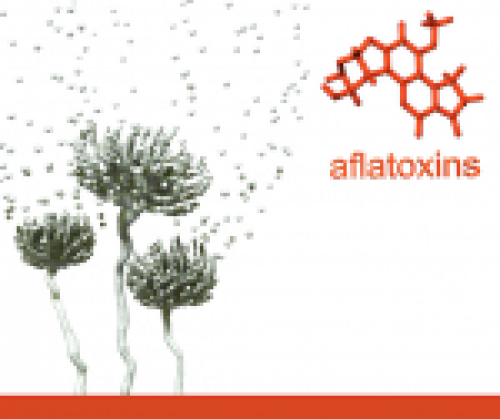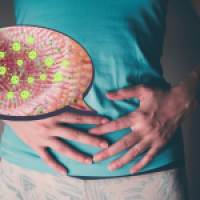Aflatoxin: A Dangerous Mycotoxin

Article Summary
Aflatoxins are harmful toxins made by certain fungi that grow on food like grains, nuts, and spices. These toxins can make people sick without them even knowing it. Aflatoxins can cause serious health problems, including liver cancer, weakened immune systems, and slow growth in children. Some people may also feel tired all the time, have trouble thinking clearly, or experience allergic reactions because aflatoxins can affect the immune system. Scientists are researching ways to remove these toxins from the body, but it is a challenging process.
Because aflatoxins can hide in food, it is important to take steps to avoid them. People can protect themselves by storing food properly in cool, dry places and eating a variety of foods instead of relying on just one type of grain or nut. Functional medicine experts recommend using natural binders like activated charcoal and bentonite clay to help remove aflatoxins from the body. Eating foods rich in antioxidants, such as turmeric and grapes, can also help the body fight off the damage caused by aflatoxins.
If you think you have been exposed to aflatoxins, testing is available to check for these toxins in your system. Functional medicine practitioners can help identify aflatoxin levels and recommend ways to detox safely. If you want to know more about testing and functional medicine coaching, check out Shannon at Intentional Wellness, Inc. Taking steps to reduce aflatoxin exposure and support the body’s natural detox process can improve overall health and well-being.
Want to know more details?
Check out the full article below.
Mycotoxin contamination poses a serious threat to human health, with Aflatoxins (AFs) being among the most detrimental mycotoxins. These dangerous toxins can get into food supplies and make people sick without them even knowing it. These toxins are produced by fungi such as Aspergillus flavus and Aspergillus parasiticus, commonly present in the production and preservation of grain and feed. This means that foods like corn, peanuts, and some spices can sometimes contain aflatoxins without any visible signs of contamination. The toxic effects of AFs, including carcinogenic, teratogenic, and mutagenic properties, can adversely impact both animal and human health. This means they can cause cancer, birth defects, and even changes in a person’s DNA. Functional Medicine Practitioners around the world are working to help people get rid of aflatoxins that have accumulated in their bodies.
The Challenge of Getting Rid of Aflatoxins
Addressing the removal of AF has become a significant challenge. Because aflatoxins are so small and can hide inside the body, it is difficult to completely remove them without special treatments. Current research is looking at microorganisms with detoxification capabilities, exploring their mechanisms, the safety of degrading enzymes, and applying these microorganisms as detoxification strategies for AFs. Scientists are studying good bacteria that can break down aflatoxins and make them less harmful. The aim is to establish a reliable reference strategy for the biological detoxification of AFs. This would help people get rid of these toxins naturally, without relying on harsh chemicals or medications.
Aflatoxins are a Carcinogen
Aflatoxins, known for causing liver cancer, particularly in individuals with hepatitis B, have far-reaching health implications. When aflatoxins build up in the liver, they can damage cells and make it harder for the body to filter toxins. Prolonged exposure is associated with immunodeficiency, immunosuppression, stunting, kwashiorkor, and interference with children’s micronutrient metabolism. This means that children who eat contaminated food may not grow properly or get the vitamins and minerals they need to stay healthy. Regions with poor control and monitoring systems often experience high aflatoxin levels in staple foods, leading to chronic exposure for consumers. In these areas, people may eat contaminated food every day without realizing that it is slowly making them sick.
Aflatoxins May Worsen Mast Cell Disorders
Although the precise connection between aflatoxin and MCAS is not well-established, it is theorized that aflatoxin exposure may contribute to immune system dysregulation, potentially triggering or exacerbating MCAS symptoms. MCAS, or Mast Cell Activation Syndrome, is a condition where the immune system overreacts and causes problems like rashes, digestive issues, and trouble breathing. Mast cells are involved in the body’s defense against pathogens, and any disruption in their function could potentially lead to an abnormal immune response. If aflatoxins interfere with mast cells, it might make symptoms worse and harder to control.
Where Aflatoxins Come From & How They Cause Harm
Produced by Aspergillus fungi, aflatoxins’ levels are influenced by climatic conditions, and both pre- and post-harvest measures are essential to prevent contamination. These fungi grow best in warm, humid places, which is why aflatoxins are common in tropical and subtropical regions. The severity of aflatoxin’s impact extends beyond liver-related issues, affecting the immune system, gut flora, brain barrier function, and pregnancy. This means that exposure to aflatoxins can make it easier for people to get sick, cause digestive problems, and even harm unborn babies. Aflatoxin weakens defenses against viruses, increases susceptibility to respiratory infections, and correlates with various health issues, including birth defects, anemia in pregnancy, premature birth, and stunted growth in children. Pregnant women who eat food contaminated with aflatoxins may pass the toxins to their babies, which can lead to serious health problems. It has been shown that aflatoxin can cross the blood-brain barrier and cause damage to the brain, leading to brain fog and much worse. This could explain why some people with aflatoxin exposure feel tired all the time or have trouble concentrating. In addition to its health impacts, aflatoxin is associated with mold sources, specifically Aspergillus flavus and Aspergillus parasiticus, and manifests in various signs and symptoms, such as dark urine, fatigue, anemia, and liver pain. These symptoms can sometimes be mistaken for other illnesses, making it hard to know if aflatoxins are the cause. Aflatoxin exposure can also lead to chronic conditions like accelerated aging, reduced immunity, and toxic metal accumulation. Over time, the damage from aflatoxins can make a person feel weak, look older than they are, and get sick more often.
Incidence of Aflatoxin in the United States
Aflatoxins are toxic substances produced by certain molds, particularly Aspergillus flavus and Aspergillus parasiticus. In the United States, strict regulations and monitoring have generally kept aflatoxin levels in food low. The U.S. Food and Drug Administration (FDA) has set action levels of 10–20 micrograms per kilogram (μg/kg) for human food and 0.5 μg/kg for milk to control aflatoxin contamination.
Despite these measures, aflatoxin contamination still occurs. A study evaluating grain products in Georgia found total aflatoxin levels averaging 8.44 μg/kg in corn and 68.22 μg/kg in peanuts, with some samples exceeding FDA action levels. Additionally, changing climate conditions, such as rising temperatures and droughts, are expected to increase aflatoxin contamination in crops like corn. Research indicates that 89.5% of corn-growing counties in 15 U.S. states may experience higher aflatoxin levels by 2031–2040 compared to the past decade.
How to Get Rid of Aflatoxin
Mitigating the effects of aflatoxin involves adopting a therapeutic diet rich in antioxidants, protein, essential fatty acids, and specific nutrients such as Vitamin D, Vitamin E, DHA, turmeric, glutathione, melatonin, quercetin, resveratrol, grape seed extract, and red sage. These nutrients help the body repair itself and fight off the harmful effects of aflatoxins. While these dietary measures may aid in alleviating aflatoxin-induced cell injury. Likewise, mycotoxin binders can help to grab ahold of mycotoxins in the body and help escort them out through the digestive pathway. Binders like activated charcoal and bentonite clay work like sponges, soaking up toxins and carrying them out of the body through waste.
Strategies for Prevention and Protection
Minimizing aflatoxin exposure is essential for maintaining health, particularly for those with compromised detoxification pathways or immune function. A combination of proper food storage, dietary strategies, and targeted supplementation can significantly reduce the risk of aflatoxin accumulation in the body. Below are key strategies to prevent exposure and protect against its harmful effects:
1. Proper Food Storage
Aflatoxin contamination is most commonly linked to poor food storage conditions that encourage mold growth. Foods such as nuts, grains, dried fruits, and spices should be stored in a cool, dry environment to inhibit fungal growth.
- Airtight Containers: Storing grains, nuts, and susceptible foods in airtight glass or BPA-free plastic containers can help prevent moisture accumulation, reducing the risk of mold.
- Refrigeration & Freezing: Keeping high-risk foods, like nuts and flours, in the refrigerator or freezer can significantly slow down fungal growth and toxin production.
- Proper Drying Methods: If drying foods at home, ensure they are dried quickly and thoroughly to avoid moisture retention, which can promote aflatoxin formation.
- Frequent Rotation & Inspection: Consuming food before expiration and inspecting it for visible signs of mold can also help reduce exposure.
2. Dietary Diversification
Regularly consuming a diverse diet helps minimize reliance on a single staple food that may be at risk of aflatoxin contamination. Certain food crops—such as corn, peanuts, and tree nuts—are more susceptible to aflatoxin than others.
- Rotating Food Sources: Incorporating a variety of grains (quinoa, rice, millet, buckwheat) instead of depending solely on corn or wheat can help reduce aflatoxin exposure.
- Organic and Lab-Tested Foods: Opt for organic products that undergo mycotoxin screening, as organic brands often implement additional safety protocols to test for contamination.
- Incorporating Anti-Fungal Foods: Certain foods, such as garlic, onions, ginger, and turmeric, have natural antifungal properties and may help the body resist aflatoxin-related fungal infections.
3. Mycotoxin Testing
For those living in humid or high-risk areas, testing for mycotoxins in food and the body can be a proactive approach to minimize exposure.
- Home Testing Kits: Affordable home test kits for mycotoxins can be used to check foods like grains, nuts, and coffee before consumption.
- Functional Medicine Testing: Specialized urine or blood tests can help determine if aflatoxins or other mycotoxins have accumulated in the body, guiding detoxification strategies.
- Food Source Testing: Commercial producers often test food supplies, but individuals can request aflatoxin-free certifications from suppliers when purchasing bulk grains or nuts.
4. Use of Natural Binders
Mycotoxin binders help remove toxins from the digestive tract by binding to them and escorting them out of the body. These natural substances may help mitigate the impact of accidental aflatoxin exposure.
- Activated Charcoal: Known for its ability to bind to mycotoxins, activated charcoal can help reduce aflatoxin absorption when taken in appropriate doses.
- Bentonite Clay: A natural detoxifier, bentonite clay binds to toxins in the gut, preventing them from entering the bloodstream.
- Chlorella & Zeolite: These detoxifying agents can assist in binding mycotoxins while also supporting heavy metal detoxification.
- Fiber-Rich Diet: Eating fiber-rich foods (flaxseeds, psyllium husk, chia seeds) supports natural elimination pathways and helps prevent toxin reabsorption.
5. Liver Support & Detoxification
The liver is the body’s primary detox organ, responsible for processing and eliminating harmful toxins, including aflatoxins. Strengthening liver function with targeted nutrition and supplementation can enhance the body’s ability to detoxify these harmful compounds.
- Milk Thistle: This well-researched herb contains silymarin, a powerful liver-protective compound that helps neutralize aflatoxin-induced liver damage.
- N-Acetylcysteine (NAC): NAC is a precursor to glutathione, the body’s master antioxidant, which plays a critical role in detoxifying aflatoxins.
- Dandelion Root: Supports bile production and helps the liver flush out toxins efficiently.
- Turmeric & Curcumin: These anti-inflammatory compounds help reduce oxidative stress and enhance liver detoxification.
- Hydration: Drinking plenty of filtered water supports kidney function, aiding in the elimination of toxins through urine.
The Role of Functional Medicine in Aflatoxin Detox
Functional medicine approaches aflatoxin detoxification through personalized interventions, assessing genetic, environmental, and lifestyle factors. Practitioners recommend tailored detoxification protocols, diet modifications, and targeted supplementation to optimize the body’s ability to eliminate toxins.Aflatoxin Detection in Functional Medicine Testing
Functional medicine practitioners often assess patients for aflatoxin exposure, especially when symptoms suggest possible mycotoxin involvement. Specialized tests, such as those analyzing urine or blood samples, are used to detect aflatoxin levels in the body. High-performance liquid chromatography (HPLC) coupled with mass spectrometry is a common method for determining aflatoxin presence due to its precision and accuracy.
The use of advanced analytical techniques allows practitioners to identify and address aflatoxin exposure effectively. This approach enables the development of personalized detoxification strategies to mitigate the health impacts of aflatoxin accumulation.
How to Test for Aflatoxins in Your System
If you suspect that you have been exposed to aflatoxins, testing is available to assess mycotoxin levels in your body. Functional medicine practitioners can run special urine or blood tests to check for aflatoxins. Functional medicine practitioners use specialized urine or blood tests to identify mycotoxin presence and determine appropriate detoxification strategies. Finding out if aflatoxins are in your body is the first step toward getting rid of them and feeling better.
If you want to know if you have this in your system, check out functional medicine testing and functional medicine coaching with Shannon at Intentional Wellness, Inc.References
-
Seawright, E. (2016). Increase in Aflatoxin Exposure in Two Populations Residing in East. National Center for Biotechnology Information. https://www.ncbi.nlm.nih.gov/pmc/articles/PMC7771519/
-
Tack, J., Yu, J., & Wu, F. (2023). Rising temps, drought likely to increase incidence of aflatoxin in corn. Kansas State University Research and Extension News. https://www.ksre.k-state.edu/news/stories/2023/04/agriculture-climate-change-impact-on-aflatoxin.html
-
Ramesh, T., et al. (2013). Aflatoxin tests in herbal products and its quantification: Latest updates. National Center for Biotechnology Information. https://www.ncbi.nlm.nih.gov/pmc/articles/PMC9493432/
-
Pfoley Clinic. Top 4 Functional Medicine Tests Screening for Mould Toxicity. https://www.pfoleyclinic.com/single-post/top-4-functional-medicine-tests-screening-for-mould-toxicity

Further Reading: Mold and Mycotoxins
- Recognizing the Symptoms of Mold Toxicity
- How mycotoxins impact our energy production and mitochondria
- Mold: A frequently overlooked cause of invisible illness
- Mycotoxin Binders
- Understanding the Citrinin Mycotoxin
- Could mold be causing your Mast Cell Disorder?
- How mycotoxins impact our energy production and mitochondria
- Why Mold Detox is Harder with MCAS



